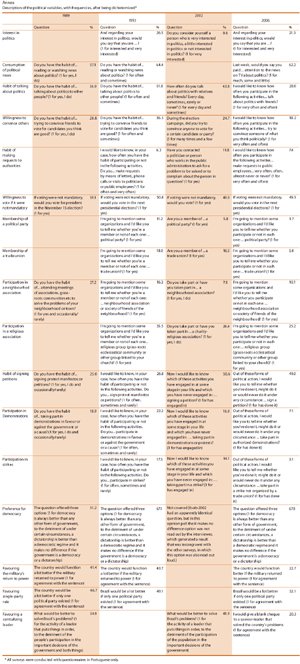Meu SciELO
Brazilian Political Science Review (Online)
versão On-line ISSN 1981-3821
Braz. political sci. rev. (Online) vol.5 no.se Rio de Janeiro 2010
The decreasing political rewards of education in Brazil
Rogerio Schlegel
Centre for Metropolitan Studies/Brazilian Center for Analysis and Planning (CEM/Cebrap), Brazil
Replicated from Brazilian Political Science Review (Online), Rio de Janeiro, v.4, n.2, 2010. ABSTRACT The conventional perspective in Political Science expects a strong association between education and political behaviour favourable for democratic coexistence. This approach also infers that increases in a nation's educational attainment levels will be accompanied by sustained gains in attitudes such as political engagement and democratic support. These hypotheses have been reviewed and tested for Brazil, with analyses of surveys conducted between 1989 and 2006. The evidence confirms the conventional perspective when a single point in time is observed and dimensions of associativism are excepted. However, longitudinal analysis between the two extremities of the period revealed decreasing rewards for schooling added up by different levels of education - particularly the upper secondary - in several dimensions of participation and support for democratic principles. Keywords: Education; Political behaviour; Democracy; Participation. Introduction This article raises evidence that recent Brazilian schooling efforts have brought decreasing political rewards in terms of favouring attitudes and behaviours related to democratic coexistence. Evaluating participation and support for democratic principles, the gains at the individual level represented by different levels of education - the upper secondary, above all - are currently smaller than in the 1980s in several dimensions. Time series constructed using national surveys conducted between 1989 and 2006 indicate a convergence in the political behaviour of citizens with varied levels of schooling. It is these data that are explored in this article. Further tests, which are part of the same research programme, allow one to quantify this tendency. Differently from what took place in the late 1980s, today, Brazilians who concluded their secondary studies are no different from those who have not finished lower secondary education in terms of preferring democracy over any other political regime. The odds of someone with a university diploma being very interested in politics in 1993 was 3.6 times higher than of someone who had not done the first 8 years of school; by 2006, this figure had dropped to 1.6 times (Schlegel 2010). These and other findings along the same lines call into question the conventional perspective in the field, which expects increases in a nation's educational attainment levels necessarily leading to the enhancement of behaviours favourable to democracy. They also advise against banking on education as a panacea capable of promoting a superior form of citizenship on its own. The confines of the article prevent one from discussing potential explanations for such decreasing rewards thoroughly. The fall in the quality of Brazilian schooling and in the cognitive capacity-building made possible by each level of education, as well as generational and contextual factors, are investigated at other stages of the research in an attempt to detect the mechanisms involved. The text has three sections beyond this brief introduction: theoretical discussion, analysis of survey data and conclusion. Theoretical Discussion Education - understood as formal and structured learning, which takes place in specialized institutions and confers credentials widely recognized in society - is one of the most relevant factors in determining citizens' political behaviour, according to the predominant perspective in Political Science. Even in multicausal models, schooling is usually pointed out as the decisive predictor of attitudes such as willingness to participate and support for democracy. At the individual level, education is the socioeconomic and demographic variable with the clearest effects in cross-sectional analyses, which cover a single point in time. In these studies, it appears in consistent, strong and positive correlation with dimensions such as political interest, media use, knowledge of political information, voter turnout, civic engagement or with indicators related with democratic attitudes, such as tolerance and political efficacy. Not by chance, education was described as the "universal solvent" in attempts to explain the different facets of political behaviour (Converse 1972). The impact of changes in a nation's educational levels was theorized only tangentially in the studies that laid the groundwork for the understanding of relations between education and politics. These analyses have a remarkable commonality: based on valid associations for higher educational levels at one point in time, similar results were usually inferred for educational levels increased over time. The assumption was always that the political effects of education have an exclusively cumulative character, in a calculation where more formal learning invariably gets translated into additive gains in terms of behaviours desirable for democratic life. The presumption that increments in years of schooling lead to sustained increase in knowledge of politics, in participation, tolerance and support for democracy can be described as the "predominant view" in academic milieus (Nie et al. 1996, 97-8). For greater clarity of argument, this view is henceforth termed conventional perspective. This approach was constructed basically using cross-sectional approaches and studies with bivariate analyses, in which there is no control of other attributes that could equally affect these behaviours. In these cases, the association between schooling and attitudes was recurrent. And this format, relating to a single point in time, constituted the standard for studies about education and democratic politics (Acemoglu et al. 2004). In this perspective, higher schooling levels were pictured as a near-necessary condition for democratic coexistence (Lipset 1959, 79), as "probably the most important" element to create interest in politics (Lazarsfeld et al. 1955, 42) and maintain adherence to democracy (Dahl 1967, 316), as a crucial determinant of the civic culture, capable of generating a differentiated political actor (Almond and Verba 1968, 315), as a factor whose expansion in society makes "very likely" an enhanced participation in and attention to politics (Converse 1972, 324) or as a direct propeller of participation (Key 1961, 329). Contemporaneously, it is not unusual for authors to explicitly recommend the raising of the population's educational attainment level as the main initiative to foster participation or intensify democracy in Brazil and in other developing nations (Booth and Seligson 2006; Evans and Rose 2007; Almeida 2007). Nevertheless, abundant empirical evidence refutes the central expectation of the conventional perspective. As early as the late 1970s, Brody (1978) presented what he called the "puzzle of political participation": indicators of political activity in the United States were displaying decreases in comparison with previous decades, in spite of robust growth in material and cognitive resources - particularly in educational attainment levels - among the population as a whole. Nie et al. (1996) demonstrated the stagnation or decline in different dimensions of participation and attention paid to politics by US citizens in the period of 1972 to 1994. Delli Carpini and Keeter (1996) found that knowledge of politics did not rise in the United States between the 1950s and 1990s, despite higher average educational attainment levels. In an analysis of 94 countries, Acemoglu et al. (2004) ascertained that nations that experienced increases in educational attainment levels between 1970 and 1995 were not likely to become more democratic by Freedom House criteria. Brazil is a promising case for investigating the impacts of shifts in schooling because of its singular educational system development. Over the last two decades, access to school has undergone spectacular growth in the country, reaching previously unseen proportions and at pace that is hard to match in the rest of the world (Castro 2007; Menezes Filho 2007). There was a clear elevation in the population's attainment levels (Barro and Lee 2000), but followed by losses in the quality of learning - defined in terms of the retention of knowledge and the development of cognitive capabilities (Schwartzman 2005; Oliveira and Araújo 2005; Castro 2009). Will this expansion have produced the superior citizen forecast by the conventional approach, that is, someone who is interested in politics, is participative and has a higher attachment to democracy? There are theoretical and methodological reasons to doubt an answer in the affirmative. The expectations of the conventional approach as to the influence of education over time were constructed with inferences based on effects observed in cross-sectional studies. Their validity is dubious. For example, it is possible that the association between schooling and political behaviours results from the action of third, omitted factors, such as economic development (Inglehart and Welzel 2008) or its combination with political development (Acemoglu et al. 2004) in the case of adherence to democracy. This perspective also assumes that the political effects of education have an exclusively additive and cumulative character. Behind this rests the idea that the political impact of education is owed just to the increase in cognitive capabilities it fosters. This means neglecting the positional effects of schooling - relative in character - that have been described in influential studies (Bourdieu and Passeron 1990; Nie et al. 1996). The credentials conferred by school are relevant in defining the resources with which citizens will count over the course of their lives. The value of a given credential depends on how rare or widespread it is in society. Hence, the political impacts do not depend only on education in absolute terms, but also on the educational environment in which citizens are placed. It is possible to think of the hypothesis that the expansion of access to school generates an inflation of credentials, diminishing the political impact of each level concluded. Moreover, schooling implies conveying values. By going to school, individuals are socialized in the prevailing normative orientations of society or of their group. It is a channel for maintaining or changing values, and for learning the forms that social coexistence should have, thus contributing to the internalization of social rules such as those related with democracy (Inglehart 1993; Jackman 1972; Thomsen 2009). This is a process in which additive effects are less evident. The dominant values in different communities will not necessarily be strictly democratic ones, and neither will schools necessarily be committed to this form of government. Lastly, schooling can be a powerful determinant of the political behaviours analysed here, but there are other factors that also impact these variables. Let us take the case of adherence to democratic principles: individual socioeconomic attributes appear as predictors of greater support for democracy in recurring fashion, but contextual and institutional factors - such as the experience of individual actors with the regime and its concrete operation - can play an even more relevant role in this relation (Moisés 2010). The conventional perspective usually leaves aside the multicausal character involved in determining political behaviour. Factors other than education have an impact on the relation that citizens establish with politics. These include institutional design, other individual attributes, generational differences and the historical context itself, for instance. In the discussion of the impact of education, I work with the idea of political rewards. In Economics and Sociology, there is a widespread notion that schooling brings measurable gains in economic terms, chiefly in terms of income. I apply an analogous concept to deal with influences on political behaviour, considering them gains when applied to dimensions that I take to be favourable to democratic coexistence. In this research programme, the challenge is to ascertain whether each level of education related with the transitions between ensino fundamental (in Brazil, the first 8/9 years of school, comprising primary and lower secondary education), ensino médio (the following 3 years, or upper secondary education) and ensino superior (tertiary/higher education) offer marginal rewards in terms of political behaviour, observing dimensions of participation and of support for democratic principles. The research strategy was designed taking into account innovations from previous studies. Namely, secondary analysis of surveys from past decades, with identical or similar questions, as a way to assess the temporal trajectory of a given population's subjective orientations (Page and Shapiro 1992; Cervi 2006); discrimination of the social outcomes by educational attainment level in the evaluation of the impact of education (OECD 2009); comparison of regression models at different points in time in order to capture changes in different predictors' strength of determination (Silva and Hasenbalg 2000). The investigation has two temporal axes, the cross-sectional and the longitudinal. If one observes each point in time in isolation, do attitudes and political behaviours display association with schooling in the expected way? Do better educated citizens prefer democracy more intensely over other forms of government or reject authoritarian solutions, for example? And when looking at the last few decades, have advances in the population's schooling levels been reflected in sustained gains in terms of democratic political behaviour? By also taking into account evaluations about education in Brazil and its decline in quality in the recent past, I work with the following two hypotheses: H1 - In the Brazilian context, education displays consistent association with individual political attitudes and behaviours in each point in time observed in isolation. H2 - In a longitudinal approach, the political rewards of each educational level (fundamental, médio and tertiary) at the individual level diminishes in the time span observed, calling into question the forecast of the conventional perspective as to the effects of raising a nation's average schooling. Analysis of the Data The empirical analysis used national surveys conducted in Brazil between 1989 and 20061, evaluating how Brazilians perceive and act upon politics (Table 1). The political contexts in which the questionnaires were applied at times directly influence the data observed. The 1989 survey was conducted in September, shortly before the first direct election for president after a 21-year-long military regime, and less than 12 months after the enactment of the 1988 Constitution, which represented the institutional re-establishment of civilian power. The president was José Sarney, a supporter of the dictatorship who presented himself as a civilian alternative for yet another transitional stage. The great mobilization that contributed towards re-democratization still impacted society. The party-political setting was becoming consolidated: PSDB - that later would hold the office of the presidency with Fernando Henrique Cardoso - was founded in 1988, the same year Luiza Erundina was elected to govern the city of São Paulo, the most important post held until then by PT (Workers' Party), which later would win the presidency with Luís Inácio Lula da Silva. Retail price hikes were reaching hyperinflation levels. Unemployment was high; democracy, a relative novelty. The following survey was applied in March 1993, under the impact of president Fernando Collor's resignation in December 1992, to avoid an impeachment process. Collor had been accused of commanding a corruption scheme and faced mass demonstrations, the most memorable of which called by the so-called caras-pintadas, students who marched wearing face-paint. He was the first directly-elected president after re-democratization, beating Lula da Silva in 1989. In 1993, the president was Itamar Franco, Collor's vice-president who took over with the support of other parties, such as PMDB and PSDB. Its worst phase had passed, but inflation remained a priority issue on the Brazilian agenda. Unemployment was still high. The survey was applied one month before the referendum on the political regime to be adopted in Brazil, already under the impact of the campaigns for different forms of government, including the monarchy. In the end, the maintenance of the presidentialist republic prevailed. What this poll did not capture was the wave of corruption accusations and investigations in the federal budget, known as the "Scandal of the Budget Dwarves", for these emerged towards the end of that year. The 2002 survey was conducted right after the election that took Lula da Silva to power, after Fernando Henrique Cardoso's eight-year government. With inflation under control since the 1993 Real Plan and unemployment running high, the opposition needed two rounds to win this election. The arrival at the presidency of a north-easterner who migrated to São Paulo, became a metalworker, led an organization that confronted the dictatorship and the trade union status quo, and eventually founded PT had great symbolic impact. The moderation that Lula made a point of selling as the main pillar of his platform for government was accompanied by a period of relative calm in terms of demonstrations during 2002, on the part of organizations such as Single Workers' Congress (CUT) and the Landless Rural Workers' Movement (MST). Lastly, the 2006 survey was conducted in June, after the 2005 mensalão scandal and before Lula da Silva's re-election. In this scandal, the PT government was accused of paying money in exchange for support from parties and deputies in Congress. During the campaign for his re-election, Lula came close to winning in the first round. He ended up winning in the second round with a different electoral base in comparison with four years before. This time his vote was more concentrated in the North and Northeast regions, in smaller towns and among those with less schooling. Changes in the political setting during the period under analysis are clear. Between 1989 and 2006, the declared adherence to democracy rose from 50.4% to 68.1% among the Brazilian population2. At the start of the period, the country had only just exited the military dictatorship and was testing its new Constitution. In the most recent survey, Brazil had successfully overcome Collor's impeachment scandal, a president had managed to get himself re-elected and another was about to repeat the achievement. In a planet-wide phenomenon, democracy took on airs of "the only game in town" and became the preferred political regime among those interviewed by the World Values Survey, which covers over 80% of the world's population (Inglehart 2003). On the other hand, successive scandals and relatively scarce punishment involving the Brazilian political world seem to have hurt confidence in institutions such as government, Congress and the Judiciary. In the study, I have opted to operationalize educational attainment as a set of categorical variables that refer to levels of education, following Evans and Rose (2007). Comparative research in education distances itself more and more from taking the number of years of schooling as a sound indicator (Breen and Jonsson 2005); I also follow studies that attribute greater validity to measures of schooling that take into account cycles and transitions between them. Five attainment levels were established: up to incomplete fundamental; complete fundamental; incomplete médio; complete médio; and incomplete tertiary/higher and above3. Table 2 shows the frequencies of these schooling levels in the samples. Participation and support for democratic principles were operationalized by means of 17 variables. All correspond to single questions in the questionnaires, whose answers were dichotomized so as to facilitate the comparison between the surveys. Participation variables assess different dimensions, such as everyday activities (e.g., interest in politics, the habit of talking about politics, willingness to convince acquaintances), associativism and participation along traditional paths (e.g., in political parties, trade unions, neighbourhood and religious associations) and demand-driven activities (e.g., the habit of signing petitions, participation in demonstrations and strikes). When possible, proxies were used for surveys that did not cover a particular topic accurately. The criteria for the transformation of the political variables and their frequencies are described in the Annex. In the statistical analysis over the course of the project, I worked with bivariate and multivariate procedures, such as correlations and logistic regressions. Here, I have opted to reproduce and analyse graphs with historical series relating educational attainment levels and dimensions of political behaviour, following a methodology similar to those of Page and Shapiro (1992) and Delli Carpini and Keeter (1996). This type of analysis does not allow one to control other variables relevant to understanding the relation between education and political behaviour, such as age, generation and income. Neither does it involve a more rigorous assessment of the consistency of stability or change between points in time, which might be achieved using auto-regressions, as did Cervi (2006). However, the graphs have the advantage of lending greater visibility and intelligibility to the tendencies that I aim to demonstrate and that remains little explored in the Brazilian literature. And whenever relevant, I reproduce and comment on the results obtained in more complex statistical tests. It is worth stressing that each of the 17 political variables has its own causalities and dynamics, with particular temporal trajectories. In other words, there are cases, such as the preference for democracy, which grew among the population as a whole after re-democratization, while others, such as unionization, are in clear decline when measured by the indicator I use. The curves in the graphs mirror these dynamics, with a general trend towards an enhancement of the preference for democracy and a decline in trade union membership. Since we are interested in the marginal gains brought by each educational level, the relation between the curves of the schooling subgroups matters more that their general tendency. Will the trajectory of the subgroups prove to be parallel, convergent, erratic? On the graphs, the longitudinal observation will allow one to follow the relation between educational attainment and political variable through the period under investigation. Since we are interested in the trajectory of each political behaviour, the convergence and distancing between schooling subgroups over time is more relevant than their variation in parallel. It is worth recalling that in the case of US public opinion, parallel trajectories were the usual pattern for time series involving subgroups of the population, including schooling subgroups (Page and Shapiro 1992). To the extent that it was tested, this dynamic holds for Brazil (Cervi 2006). Convergences in the curves will indicate that distances between educational attainment levels have diminished in political terms, i.e., that one schooling level has lost potential to differentiate citizens in the period studied. Conversely, divergent curves will suggest that the behaviour of each schooling segment has become more differentiated. The first time series I present refers to self-declared interest in politics - a traditional variable in studies of the field - and will be described in further detail (Graph 1). In 1989, the survey used did not ask about this, which is why the chart does not cover this year. In 1993, the association expected between schooling and political activity appeared. Brazilians in the higher schooling category (at least incomplete tertiary) were the ones most attracted to politics, with 51.9% of them reporting themselves interested or very interested in the topic. Those who had complete médio (upper secondary) come next, with 32.6% of the subgroup declaring themselves interested or very interested. Among people with incomplete médio, 24.9% gave this answer. The completion of ensino fundamental did not generate a differential in that year's survey: in the subgroup of those who did not conclude fundamental, 19% declared themselves interested or very interested, while in the subgroup of those who did, the figure was 18.7%. Therefore, on the whole, education did differentiate citizens on this item in 1993, for while 1 out of 2 respondents who went to university said they had an interest in politics, only 1 out of 5 who finished fundamental revealed the same attitude. On the graph, the proportions obtained in each of the other surveys appear plotted in succession, thus completing the time series. In 2002, the interest in politics in general drops, to recover later in 2006. But this is not the way to look at the figures that most interest us here. It is more relevant to note that in 2002 there was major convergence between the four worse educated subgroups, at around 8%; and the higher education subgroup continued to differentiate itself, at a level above 20%. In 2006, there was also a small increase in the differentiation of the complete médio subgroup. The overall assessment shows that the distance between the best and the worst educated was of 32.9 percentage points in 1993, dropping to 18.7 thirteen years later. This is an indication that in terms of interest in politics the political rewards of education shrank, chiefly for the ensino médio subgroup, which came closer to the two worst-educated subgroups. Another example of remarkable convergence between the médio and fundamental categories comes up regarding the assessment of voting (Graph 2). When it comes to the willingness to vote if voting were not mandatory4, the transition to higher education still differentiates the citizen from the remainder of the population. At the same time, ensino médio has lost effectiveness in this dimension. Both incomplete and complete médio were caught up by the lower schooling levels - incomplete médio even has a lower proportion of willingness to vote than the fundamental category. It should be noted that in the year of president Lula's re-election there was an abrupt rise in the value attached to voting among worse educated segments and the opposite movement among better educated parts of the population. That might be associated with voting intentions, since Lula's ratings were higher among the former and there was an expectation that he would eventually triumph. The distance between the highest and the lowest figures remained virtually the same throughout the period: 31.7% in 1989 and 32.9% in 2006. On aggregate, the value attached to the vote was higher right after re-democratization (59.1%) and fell to a level close to 50% over time (in order, 50.8%, 49% and 49.3%). Another dimension along similar lines: preference for democracy (Graph 3). On aggregate, there is an upward trajectory: 51.2% of the population answered they would prefer democracy over any other form of government in 1989, 67.1% in 1993 and 67.9% in 2006. Regarding the subgroups' curves, there is a clear convergence among the four worst-educated portions. On the other hand, having higher education increased citizens' differentiation in relation to the other segments - political reward grew for this category. But the most striking trajectory is that of people with incomplete ensino médio. In the last survey, this subgroup had the lowest proportion of respondents that prefer democracy. Another recurring pattern on the graphs is the general convergence of subgroups, along with significant losses in political returns for tertiary education. This trend applies to the espousal of the military's return to power, the approval of a single-party system, and the reported participation in demonstrations. In the case of the return of the military (Graph 4), there is a broad convergence, to the point of complete fundamental being no different from the two ensino médio segments. For the tertiary segment, the approximation with the other segments is owed more to the fall in support for the military than specifically to a displacement of the worse-educated subgroups. Considering the population as a whole, favouring the military's return to power shrank from 41.4% in 1989 to 22.7% in 2006. One way or another, the marginal effect brought about by higher education was to a large extent lost. Some traditional forms of participation underwent such a decline over the course of the 17 years in question that all the schooling subgroups came close to one another - as a matter of fact, if the proportions tend to zero, the segments will necessarily come together. Membership of political parties and trade unions and participation in strikes show this trend. On the union membership topic (Graph 5), the destination points of the curves are close to one another and much lower than in the late 1980s, when the trade union movement re-flourished in the country. There is a clear convergence over time, which is even more pronounced in the case of people who went to university. The distance between this subgroup and the lowest-educated one was of over 18 percentage points in 1993 and virtually disappeared in the most recent survey. The habit of signing petitions displayed a particular pattern: the parallelism expected for the curves, detected by Page and Shapiro (1992) and Cervi (2006), was reproduced. Observing this trajectory is even more relevant because this is a form of participation that is on the increase: in the late 1980s, 1 in 4 people had this habit; by 2006, this had reached nearly 1 in 2. The evolution of the incomplete médio subgroup stands out (Graph 6). At the start of the period, this segment outperformed the one just above it. However, in the most recent survey, the incomplete médio subgroup displayed a total loss of political reward, making it impossible to differentiate someone with this educational attainment level from another with complete fundamental. While the distance between those with the least schooling and the two subgroups with the most schooling barely shifted in the period, in the case of incomplete médio it fell from 19.9 to 7.9 percentage points. Two variables contradict the general convergence trend: the habit of making requests to authorities (Graph 7) and the willingness to convince others of what one thinks experienced increases in differentiation between educational attainment subgroups. For the variable regarding requests to authorities, two distinct sets are identifiable for 1993: one with the top two and another with the bottom three schooling categories. The distance between one bloc and the other is close to 2 percentage points. After 13 years, the categories diverge and the distance between the highest and the lowest schooling levels nears 9 percentage points. Considering the positive association between the variables, interviewees in the incomplete médio subgroup appear "out of place", i.e., they have the habit of making requests less often than people who hold the fundamental diploma. Lastly, another recurring pattern brought together variables whose association with education seems tenuous or non-existent. In this group one finds participation in neighbourhood and religious associations, as well as being in favour of a centralizing leader. In these cases, it is even difficult to interpret the trajectory of the schooling subgroups, since their disposition seems erratic, demonstrating neither positive nor negative associations. In sum, there is an overall trend that predominates in this section: curves whose tendency over time is to converge, indicating decreasing political rewards for the higher educational attainment levels. The decline in this reward for education is more marked for the two categories related to upper secondary education (ensino médio, incomplete and complete), but also affects the tertiary subgroup in several topics, like interest in politics and participation in demonstrations. Another regular feature is the fact that people who experienced ensino médio but did not conclude it do not differ from those who only finished ensino fundamental in their political behaviour. This occurs in relevant dimensions such as willingness to vote if it were not mandatory and preference for democracy. Table 3 summarizes the set of time series. The columns show whether there is association (positive or negative) in each point in time, report the predominant trend in the curves' trajectories and compare the two extreme time points of the period. The results may be outlined in five points: In general, the expected association between education and political behaviour appeared in the analysis of each point in time taken in isolation. In contemporary Brazil, the better educated are the ones most interested in politics, the ones who develop the most activities directly or indirectly related to this field and the ones most supportive of democratic principles. But there are notable exceptions: participation in neighbourhood associations and religious associations did not show this relationship in time series analyses - an outcome confirmed by tests using the Pearson correlation and logistic regressions (Schlegel 2010). The results for participation in political parties and trade unions suggest an association with education that is tenuous, at most. In dimensions of civic engagement, therefore, education does not fulfil the promise of being the "universal solvent". In longitudinal terms, the most striking evidence is the decrease in political rewards observed in the 17-year period analysed, above all in the dimensions relating to democratic support. In three of the topics evaluated (preference for democracy, support for military government and support for single-party rule), the curves were convergent. With respect to support for a leader who solves things in centralized fashion, the trajectory of the curves suggested stability, but inferential tests showed a fall in the political reward. Logistic regressions indicated that each year at school increased by 3.4% the chance of rejecting a centralizing leader in 1989, but by 2006 it was no longer possible to state that more schooling represented greater rejection of this type of government. As for participation, convergent curves were the most frequent pattern, suggesting that differentiation between the educational attainment groups shrank in these two decades. But this did not happen in equally consistent fashion for all the topics. Deep-seated orientations or dimensions related to everyday activities - such as interest in politics, willingness to vote if it were not mandatory and habit of talking about politics - were the ones that demonstrated decreasing returns most clearly, including in inferential analyses. Correlations and logistic regressions also revealed a fall in marginal gains attributable to higher educational attainment levels over time. Participation dimensions that may be grouped together under the heading of "demand-driven" topics - the habit of making requests to authorities, willingness to sign petitions, participation in demonstrations and strikes - did have curves with parallel or convergent trajectories in the set of time series. However, the loss of political rewards in these topics seems to be concentrated in certain educational attainment levels, as suggested by logistic regressions. Based on all the analyses undertaken, it is possible to state that education maintained or enhanced its impact in these topics, with localized losses for some levels. Ensino médio was the category that displayed decreasing political returns in the most pronounced manner, spread over many topics. In 1989, a citizen who had completed ensino médio was 66% more likely to prefer democracy over any other regime, in comparison with one who had not completed ensino fundamental. By the second half of the 2000s, it was impossible to differentiate between people with these two educational profiles regarding preference for democracy, considering multivariate statistical tests. Ensino médio is precisely the educational level that has undergone the largest expansion in enrolment during the period analysed. Conclusion All in all, should this article's hypotheses be rejected or confirmed? The data suggest that the association expected by the conventional perspective between education and dimensions of political behaviour desirable for democratic coexistence tends to be reproduced in the Brazilian context, if isolated points in time are observed. But this relation did not display consistency for topics linked to civic engagement, such as participation in neighbourhood associations and religious associations, as well as in political parties and trade unions. As for hypothesis 2, which proposes that the rise in the population's average educational attainment level over time was not necessarily accompanied by sustained gains in terms of political behaviour, the evidence gathered here also signals its confirmation. Evidence was found to the effect that Brazilian education is bringing decreasing political rewards in various dimensions of participation and, primarily, in terms of support for democratic principles. Decreasing rewards such as those found in this study call into question the validity of the conventional perspective from a longitudinal point of view. There is no way to ensure sustained political gains for the community when the aggregate educational attainment level rises, but parts of the educational process diminish or lose their capacity to add returns in terms of political behaviour. Nevertheless, these conclusions are not equivalent to maintaining that the recent expansion of the Brazilian educational system did not have an impact, whether on the individual or the aggregate level. Or that decades of extensive studies pointing out the association between education and political behaviour are simply worthless. My point is that there are flaws in the conventional theorization of the field with reference to the effects over time; in the case of Brazil, the political impacts of education proved to be smaller than what would be expected based on this approach. All things considered, the evidence provided in this study stands as a warning against bets on education alone as a panacea capable of promoting a superior citizenship and of overcoming democratic deficits in Brazil. In a nutshell: education matters, but is no solution by itself. Uncovering the mechanisms behind the decreasing rewards of Brazilian education is a task that goes beyond the confines of this article. Might it be that lower quality education in the present means that a schooling level completed, or the same number of years studied, represents less cognitive training than in the past? Does the democratization of educational credentials lead certain diplomas to be worth less in terms of propelling individuals to privileged positions in society? Are schools really making an effort to educate democratic citizens, beyond developing technical skills and training for the market? Not only are these questions on the top of the international research agenda, but, owing to their relevance, they also deserve a prominent place on the research horizon of Brazilian analysts. Notes 1 These opinion polls were coordinated by José Álvaro Moisés (University of São Paulo, Political Science Department) and/or Rachel Meneguello (State University of Campinas, Political Science Department), whom I thank for allowing me to use these data. 2 These rates were gathered from the previously described databases. 3 For the sake of standardization, I adopt the current nomenclature for Brazilian educational levels. Hence, the old primário and ginasial combined cycle, later called primeiro grau, is described as ensino fundamental. The old científico and segundo grau are called ensino médio. 4 In Brazil, voting is compulsory for citizens aged 18 to 70, and there is no need to enlist for each election. For this reason, attendance at the polls is not a consistent indicator of political activity and surveys habitually include the question about willingness to vote if it were not compulsory in order to assess how valued the vote is. Bibliographical References Acemoglu, Daron, Simon Johnson, James A. Robinson, and Pierre Yared. 2004. From education to democracy? Paper presented at the Department of Economics, MIT, December 15, in Massachusetts, USA http://ssrn.com/abstract=665842 (accessed April 12, 2009). Almeida, Alberto C. 2007. A cabeça do brasileiro. Rio de Janeiro: Editora Record, 2007. Almond, Gabriel, and Sidney Verba. 1968. The civic culture: Political attitudes and democracy in five nations. Princeton: Princeton University Press. Barro, Robert J., and Jong-Wha Lee. 2000. International data on educational attainment: Updates and implications. Working Paper presented at Center for Interational Development (CID), no. 42. http://www.cid.harvard.edu/ciddata/ciddata.html (accessed June 8, 2009). Booth, John A., and Mitchell A. Seligson. 2006. Inequality and democracy in Latin America: Individual and contextual effect of wealth on political participation. Paper presented at the Workshop on Poverty and Democracy, February 17-18, in Duke University, Durham, NC. Bourdieu, Pierre, and Jean-Claude Passeron. 1990. Reproduction in education, society and culture. London: Sage. Breen, Richard, and Jan O. Jonsson. 2005. Inequality of opportunity in comparative perspective: Recent research on educational attainment and social mobility. Annual Review of Sociology, no. 31:223-43. Brody, Richard. 1978. "The puzzle of political participation in America". In The new American political system, A. King. Washington, D.C: American Enterprise Institute for Public Policy Research. Castro, Jorge A. 2009. Evolução e desigualdade na educação brasileira. Educ. Soc. Campinas 30 (108): 673-97. Castro, Maria H. G. 2007. "O desafio da qualidade". In O Brasil tem jeito?, ed. Arthur Ituassu and Rodrigo Almeida. Rio de Janeiro: Jorge Zahar Editora. Cervi, Emerson U. 2006. Opinião pública e política no Brasil - o que o brasileiro pensa sobre política e por que isso interessa à democracia. Ph.D. thesis, Iuperj, Rio de Janeiro. Converse, Philip E. 1972. Change in the American electorate. In: The human meaning of social change, Angus Campbell and Philip E. Converse. New York: Russel Sage Foundantion. Dahl, Robert. 1967. Pluralist democracy in the United States. Chicago: Rand McNally. Delli Carpini, Michael X., and Scott Keeter. 1996. What Americans know about politics and why it matters. New Haven: Yale University Press. Evans, Geoffrey, and Pauline Rose. 2007. Education and support for democracy in Sub-Saharan Africa: Testing mechanisms of influence. Afrobarometer Working Paper, no. 75. http://www.afrobarometer.org/papers/AfropaperNo75.pdf. (accessed September 30, 2009). Inglehart, Ronald. 1993. Democratização em perspectiva global. Opinião Pública, no. 1. Inglehart, Ronald. 2003. How solid is mass support for democracy and how can we measure it? PS Political Science and Politics 36 (1): 51-7. Inglehart, Ronald, and Christian Welzel. Modernization, cultural change, and democracy. New York: Cambridge University Press, 2008. Jackman, Robert W. 1972. Political elites, mass publics, and support for democratic principles. Journal of Politics 34:753-73. Key, V. O. Public opinion and American democracy. New York: Knopf, 1961. Lazarsfeld, Paul F., Bernard Berelson, and Hazel Gaudet. 1955. The people's choice. New York: Columbia University Press. Lipset, Seymour M. 1959. Some social requirements of democracy: Economic development and political legitimacy. American Political Science Review, no. 53:69-105. Menezes Filho, Naércio. 2007. Os determinantes do desempenho escolar no Brasil. São Paulo: Instituto Futuro Brasil/Ibmec-SP/FEA-USP. Moisés, José Álvaro. 2010. Cultura política, instituições e democracia: lições da experiência brasileira. In Democracia e confiança: por que os cidadãos desconfiam das instituições públicas, ed. José Álvaro Moisés. São Paulo: Edusp. Nie, Norman H, Jane Junn, and Kenneth Stehlik-Barry. 1996. Education and democratic citizenship in America. Chicago: University of Chicago Press. OECD. 2009. Education at a glance 2009: OECD indicators. Paris: OECD. http://www.oecd.org/dataoecd/41/25/43636332.pdf (accessed February 12, 2010). Oliveira, Romualdo P., and Gilda C. Araújo. 2005. Qualidade do ensino: uma nova dimensão da luta pelo direito à educação. Revista Brasileira de Educação, no. 28:5-23. Page, Benjamin, and Robert Shapiro. 1992. The rational public: Fifty years of trends in Americans' policy preferences. Chicago: University of Chicago Press. Schlegel, Rogerio. 2010. Educação e comportamento político: os retornos políticos decrescentes da escolarização brasileira recente. Ph.D. thesis, Political Science Department, University of São Paulo. www.teses.usp.br/teses/disponiveis/8/8131/tde-14102010-105934/pt-br.php (accessed January 30, 2011). Schwartzman, Simon. 2005. Os desafios da educação no Brasil. In Os desafios da educação no Brasil, ed. Colin Brockl. Rio de Janeiro: Nova Fronteira. Silva, Nelson do Valle, and Carlos Hasenbalg. 2000. Tendências da desigualdade educacional no Brasil. Dados 43 (3). www.scielo.br/scielo.php?script=sci_arttext&pid=S0011-52582000000300001&lng=en&nrm=iso (accessed October 26, 2009). Thomsen, Jens Peter. 2009. The "faces of education" controversy: Socialization, cognitive resources or economic privileges? Paper presented at the ISPP 32nd Annual Scientific Meeting, Trinity College, July 14, in Dublin, Ireland. www.allacademic.com//meta/p_mla_apa_research_citation/3/0/8/7/5/pages308755/p308755-1.php (accessed September, 2009).
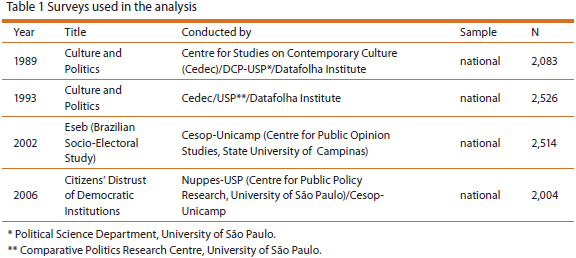
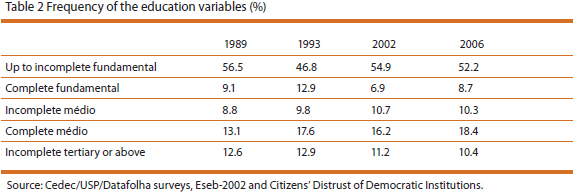
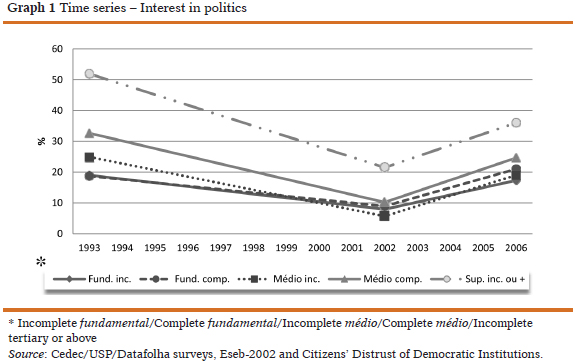
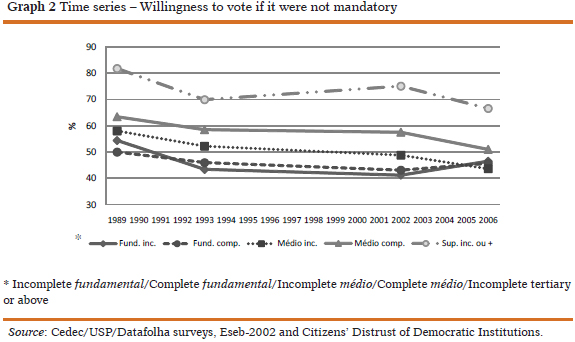
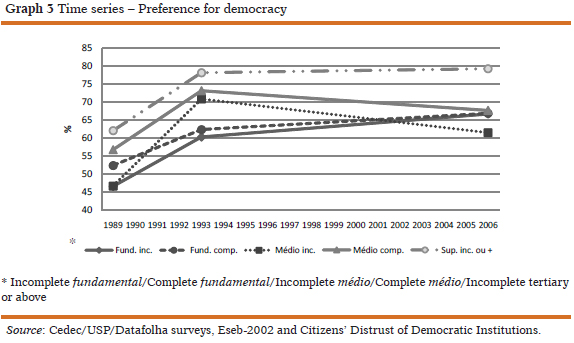
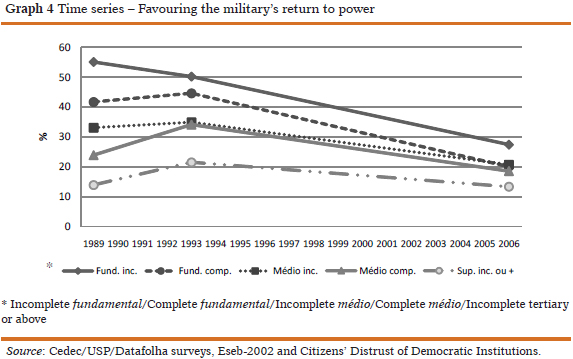
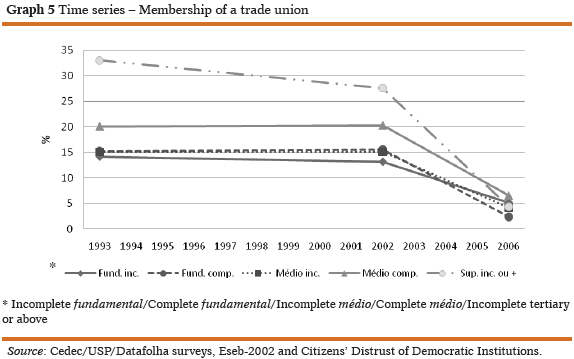
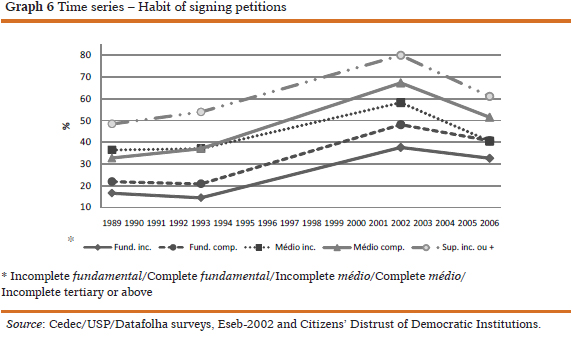
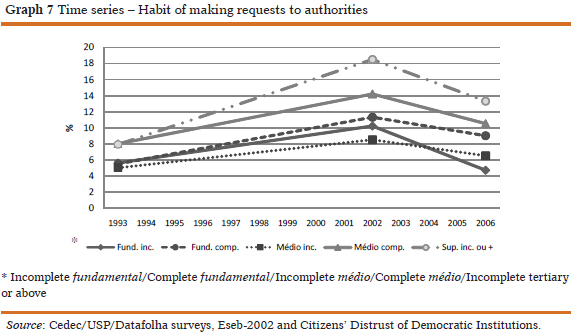
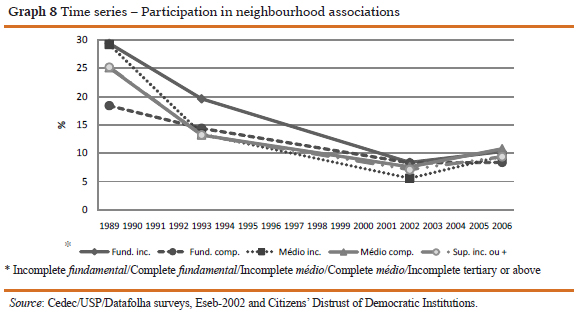
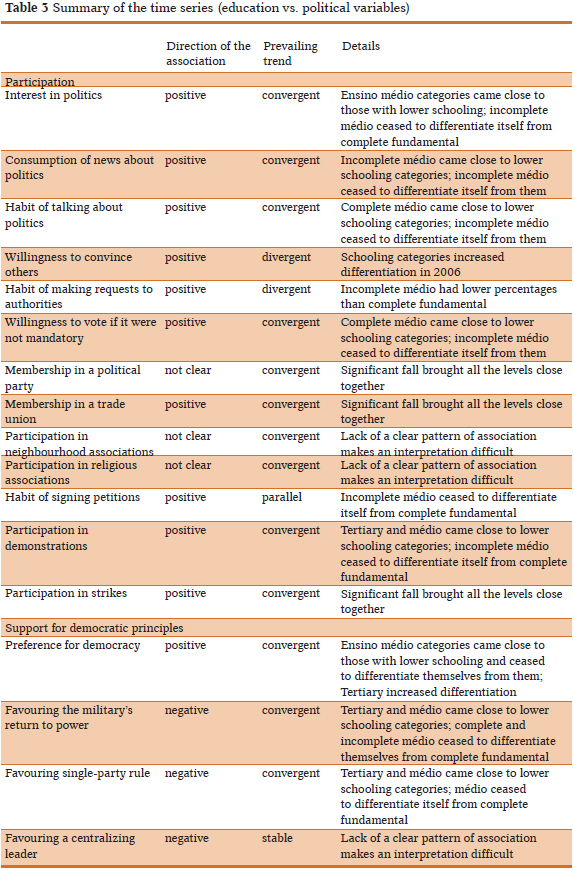
Submitted in september 2010
Accepted in november 2010
Annex













